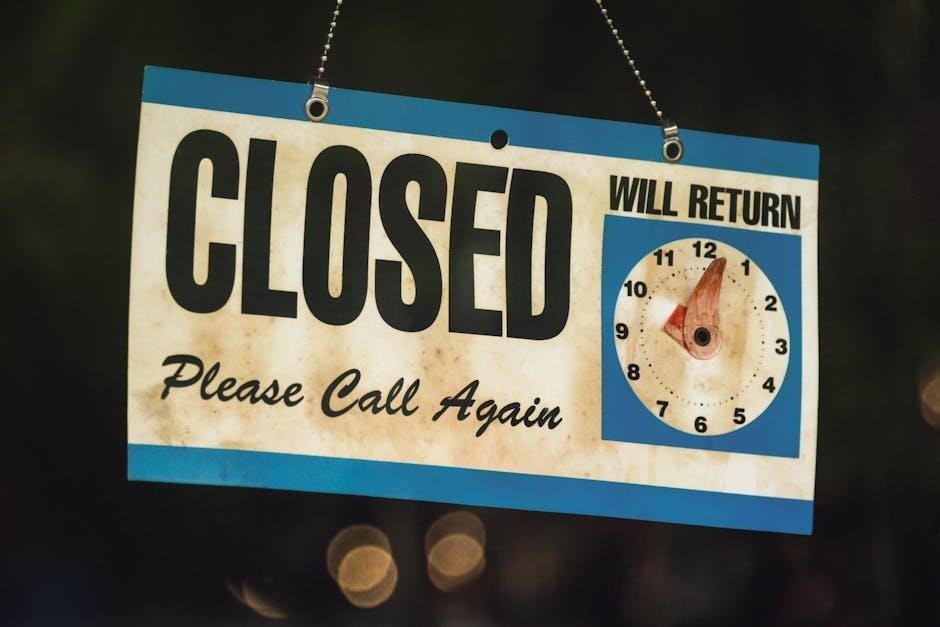The Notice of Intent to Lien in Colorado is a critical legal document used to notify property owners of potential lien filings due to unpaid debts․
It serves as a preliminary step before filing a mechanics lien‚ ensuring compliance with Colorado’s construction payment laws and protecting the rights of contractors and subcontractors․
1․1 Overview of the Notice of Intent to Lien
The Notice of Intent to Lien is a legal document informing property owners and contractors of a potential lien filing due to unpaid debts․ It outlines the claimant’s intention to secure payment through a mechanics lien‚ ensuring transparency and compliance with Colorado construction laws․ This step is crucial for contractors seeking payment recovery․
1․2 Importance of the Document in Colorado
The Notice of Intent to Lien is crucial in Colorado as it ensures legal compliance and protects contractors’ rights to payment recovery․ It provides clarity to property owners about potential liens‚ fostering transparency in construction payment processes and preventing unexpected disputes․ This document is essential for maintaining the integrity of Colorado’s construction payment laws․
Legal Requirements for Filing a Notice of Intent to Lien
Filing a Notice of Intent to Lien in Colorado requires strict adherence to legal timelines and procedures‚ ensuring all parties are notified properly to avoid disputes and maintain compliance․
2․1 Who Can File a Notice of Intent in Colorado?

In Colorado‚ general contractors‚ subcontractors‚ suppliers‚ and laborers involved in a construction project can file a Notice of Intent to Lien if they haven’t received payment for their services or materials․ This ensures everyone contributing to the project can legally protect their right to payment․
2․2 Timeframe for Serving the Notice
In Colorado‚ the Notice of Intent to Lien must be served at least 10 days before filing a mechanics lien․ This deadline is strictly enforced to ensure property owners are notified promptly․ Failure to meet this timeframe can result in the lien being deemed invalid․ Contractors must adhere to Colorado’s lien laws to maintain their rights;
2․3 Eligibility Criteria for Lien Claimants
In Colorado‚ lien claimants must be general contractors‚ subcontractors‚ or suppliers who provided labor‚ materials‚ or services for property improvement․ The claimant must have a direct contract with the property owner or a subcontractor․ The services or materials provided must be directly tied to the improvement of the specific property in question․
The Role of the Notice of Intent to Lien
The Notice of Intent to Lien serves as a formal warning to property owners about potential lien filings due to unpaid debts‚ aiming to prompt payment resolution․
3․1 Purpose of the Notice

The purpose of the Notice of Intent to Lien is to inform property owners and contractors about unpaid debts‚ prompting payment resolution and preventing lien filings․ It ensures transparency and provides an opportunity to settle disputes before legal action commences‚ protecting both parties’ interests in Colorado construction projects․
3․2 How It Protects Contractors and Subcontractors
The Notice of Intent to Lien safeguards contractors and subcontractors by providing formal notice to property owners‚ ensuring payment for services rendered․ It grants leverage to negotiate settlements and prevents unpaid debts‚ protecting their rights under Colorado law and avoiding prolonged legal disputes․
3․3 Impact on Property Owners
The Notice of Intent to Lien alerts property owners to potential liens‚ creating urgency to settle unpaid debts․ It protects their property value by prompting resolution before a lien is filed‚ ensuring clarity and compliance with Colorado law‚ and avoiding legal complications that could affect their ownership rights․

Preparing the Notice of Intent to Lien
Preparing the Notice requires including project details‚ unpaid amounts‚ and legal references․ Ensure accuracy in names‚ addresses‚ and payment specifics to avoid filing issues․
4․1 Required Information for the Notice
The Notice must include the property owner’s name‚ project description‚ unpaid amount‚ and legal references․ Accurate details ensure compliance with Colorado’s lien laws and prevent filing delays․ Include contractor and claimant information for proper documentation․
4․2 Steps to Complete the Form
Fill out the form with the claimant’s name‚ property owner’s details‚ project description‚ and unpaid amount․ Include the legal description of the property and reference the Colorado Revised Statutes․ Ensure all fields are accurately completed to avoid delays in processing․
4․3 Reviewing and Verifying the Document
Ensure all information is accurate and complete‚ including claimant details‚ property description‚ and unpaid amounts․ Verify compliance with Colorado lien laws and timelines․ Double-check for errors or omissions to avoid delays․ Confirm the document adheres to legal standards and is properly signed and notarized before submission;
Filing Deadlines and Procedures

In Colorado‚ the Notice of Intent to Lien must be served at least 10 days before filing the lien․ The mechanics lien itself must be filed within 4 months after the last provision of services or materials․ Proper procedures ensure compliance with state laws and avoid delays in payment recovery․
5․1 Deadline for Filing the Notice
In Colorado‚ the Notice of Intent to Lien must be served at least 10 days before filing the mechanics lien․ Contractors and subcontractors must file the lien within 4 months after the last provision of services or materials to ensure compliance with state laws and avoid losing lien rights․
5․2 How to File the Notice in Colorado
In Colorado‚ the Notice of Intent to Lien must be served on the property owner and prime contractor at least 10 days before filing․ It can be delivered via certified mail‚ personal delivery‚ or overnight courier․ Proper documentation and proof of service are required to ensure compliance with state lien laws․
5․3 Tracking the Filing Status
After submitting the Notice of Intent to Lien‚ a confirmation page will appear with payment details and a document filing number․ A PDF copy of the filing can be printed using the printer icon in the toolbar․
The document will not be immediately visible on the Secretary of State’s website until processed through an automated redaction system to remove taxpayer identification numbers․

Serving the Notice of Intent
Serving the Notice of Intent to Lien in Colorado involves providing the document to the property owner and prime contractor at least 10 days before filing the lien to ensure proper notification and prevent payment disputes․
6․1 Methods of Serving the Notice
In Colorado‚ the Notice of Intent to Lien must be served via personal delivery‚ registered mail‚ or certified mail with return receipt requested to ensure proof of service․
6․2 Proof of Service Requirements
Proof of service is mandatory‚ typically via a return receipt from certified mail or an affidavit of personal delivery‚ confirming the property owner received the Notice of Intent to Lien;
This documentation ensures compliance with Colorado’s legal standards and validates the service process for potential lien claims․
6․3 Consequences of Improper Service
Improper service of the Notice of Intent to Lien can lead to dismissal of the lien claim‚ delaying payment recovery and potentially resulting in legal penalties․
It underscores the importance of adhering to Colorado’s service requirements to maintain the validity of the lien process․

Downloading and Using the Colorado Notice of Intent to Lien PDF
The Colorado Notice of Intent to Lien PDF is easily downloadable online‚ providing a standardized template for contractors to notify property owners of potential lien filings․
7․1 Where to Find the Official Form
The official Colorado Notice of Intent to Lien form can be found on legal document websites‚ such as PDFfiller or official state resources․ It is also available through construction attorney platforms and legal aid sites‚ ensuring easy access for contractors and lien claimants․
7․2 Tips for Filling Out the PDF Form
Use a PDF editor to complete the form accurately․ Ensure all details‚ such as project specifics‚ unpaid amounts‚ and parties involved‚ are correct․ Include clear descriptions of services or materials provided․ Verify payment terms and deadlines․ Proofread before saving and printing․ Consider consulting legal experts for complex cases to avoid errors․
7․3 Saving and Printing the Completed Form
After completing the form‚ save it as a PDF to preserve formatting․ Use the print icon in the PDF toolbar for a hard copy․ Note that the document’s image won’t appear on the Secretary of State’s website until processed․ Download and save the completed form for your records and legal compliance․

Difference Between Notice of Intent and Mechanics Lien
A Notice of Intent to Lien is a warning of a potential lien filing‚ while a Mechanics Lien is the formal legal claim against the property for unpaid debts․
8․1 Understanding the Distinction
The Notice of Intent to Lien serves as a warning to property owners about potential lien filings due to unpaid debts‚ while a Mechanics Lien is the formal legal claim against the property‚ impacting its value and ownership rights until the debt is settled․
8․2 When to Move from Notice to Lien
The transition from a Notice of Intent to filing a Mechanics Lien occurs when the debt remains unpaid after the required 10-day period․ If payment is not received‚ lien claimants must proceed with filing the lien within the statutory timeframe to secure their rights and ensure payment recovery․
8․3 Legal Implications of Each
The Notice of Intent to Lien serves as a warning‚ giving property owners a chance to settle debts before a lien is filed․ A Mechanics Lien‚ however‚ creates a formal claim against the property‚ potentially leading to foreclosure if unpaid‚ and must adhere to strict filing deadlines to remain enforceable․
Common Mistakes to Avoid
Common mistakes include missing the filing deadline‚ providing incomplete or inaccurate information‚ and failing to serve the notice properly‚ which can result in loss of lien rights․
9․1 Missing the Filing Deadline
Mistakes include failing to serve the Notice of Intent to Lien at least 10 days before filing the mechanics lien․ Missing Colorado’s strict 4-month deadline for filing a lien after last providing services or materials can result in loss of lien rights‚ making it impossible to secure payment through legal means․
9․2 Incomplete or Inaccurate Information
Submitting a Notice of Intent to Lien with incomplete or inaccurate details can delay or invalidate the filing․ Missing or incorrect information‚ such as project descriptions‚ amounts owed‚ or party details‚ can lead to disputes or dismissal of the lien claim‚ complicating the payment recovery process and potentially causing legal issues for the claimant․
9․3 Failure to Serve the Notice Properly
Failure to serve the Notice of Intent to Lien properly can result in the lien being dismissed․ Proper service requires strict adherence to Colorado’s legal requirements‚ including timely delivery to the property owner and prime contractor․ Improper service can undermine the claimant’s rights‚ delay payment recovery‚ and lead to legal penalties or dismissal of the lien claim․

Consequences of Failing to File the Notice
Failing to file the Notice of Intent to Lien in Colorado can result in the loss of lien rights‚ delaying payment recovery and potentially leading to legal penalties․
10․1 Loss of Lien Rights
Failing to file the Notice of Intent to Lien in Colorado prevents claimants from securing lien rights‚ making it impossible to place a lien on the property for unpaid debts․
10․2 Delay in Payment Recovery
Failing to file the Notice of Intent to Lien delays payment recovery‚ as lien rights are lost‚ leaving contractors without leverage to secure timely compensation for their work or materials․
10․3 Potential Legal Penalties
Failing to file the Notice of Intent to Lien can result in legal penalties‚ including the inability to claim a lien‚ which may lead to unpaid debts and loss of leverage for payment recovery‚ further complicating legal proceedings․
Always ensure timely filing and proper service of the Notice of Intent to Lien to safeguard your rights and avoid legal repercussions in Colorado․
11․1 Summary of Key Points
The Notice of Intent to Lien in Colorado is a critical step for contractors and subcontractors to secure payment rights․ Serving the notice 10 days before filing is mandatory․ Compliance with state laws ensures protection against unpaid debts․ Proper filing and service are essential to avoid losing lien rights and delaying payment recovery․
11․2 Best Practices for Compliance
Always use the official Colorado Notice of Intent to Lien form and ensure accuracy in all details․ Serve the notice 10 days before filing and maintain proof of service․ Regularly track filing deadlines and verify document completeness to avoid legal penalties and loss of lien rights․ Consulting a legal expert is recommended for complex cases․
